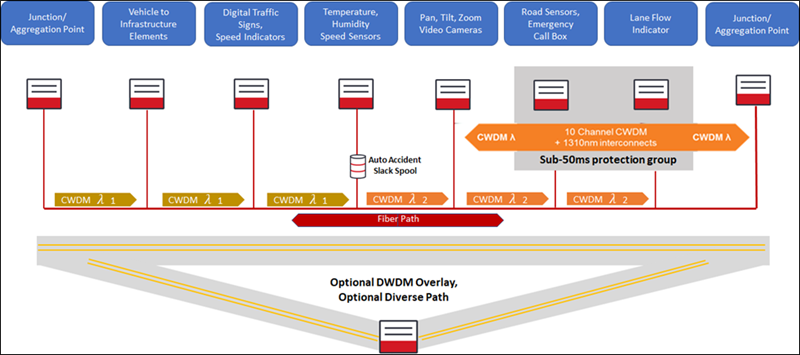Next-generation networks help DOT’s deliver quality motorist experience
On statewide highway systems, road conditions can change without warning. Snowstorms, rockslides, vehicle collisions, traffic congestion and wildlife activity are just a few examples of sudden changes that can disrupt road travel. For Department of Transportation (DOT) traffic managers in central operations centers, accessing real-time data from remote roadside “smart” devices is critical. Trying to resolve roadside problems from afar without real-time data is like trying to steer a car that has a mud-splattered windshield. Although there may be a few clear patches, it is nearly impossible to see the whole picture.
Traffic managers need real-time access to data flowing from intelligent transportation systems (ITS) technologies, smart traffic control devices and connected vehicle applications. Combining this data with analytics software provides traffic managers a clearer view of what is happening throughout the highway system. Armed with these insights they can quickly resolve problems, dispatch emergency crews, alert motorists to pending hazards, and recommend alternative routes to their destinations.
The challenge? The enormous data volume generated by video cameras, sensors, monitoring devices, vehicle to infrastructure (V2I) and other technologies can quickly clog a network increasing congestion and outages.
Just like our roadways, as the network becomes over-subscribed, latency and jitter impact application performance. For a highway system, this can delay emergency crews reaching a jackknifed semi-trailer on a busy mountain pass, repair crews clearing huge boulders cascading onto a highway, or a parent safely returning to loved ones.
To ensure a smooth flow of data between roadside devices, operations centers and data centers, DOT’s are deploying next generation fiber-optic and wireless networks.
Examples of how ITS benefited communities

Images: U.S. Department of Transportation
- A photo-radar enforcement van reduced the number of speeding vehicles by 23.7%
- A speed management system for winter maintenance resulted in a 100% reduction in winter related accidents
- Speeding dropped 65% where automated speed-enforcement systems have been installed
Source: U.S. Department of Transportation
Not only can the avalanche of data can quickly overwhelm legacy networks, but legacy network switches may not have been engineered to maximize capacity of newer fiber optics. This can result in unnecessary over-consumption of fiber capacity, which decreases the financial return on a DOT’s fiber investment.
Legacy networks can also be very complex to manage. Whenever network elements need to be repaired or replaced, it can take days to accomplish, interrupting operations and incurring additional expense.
Next generation networks for DOT’s
Upgrading to a packet- optical platform provides DOT’s a highly resilient, scalable next-generation network that meets the needs of current ITS applications, while ensuring capacity for future initiatives like autonomous vehicles. Leveraging Wave Division Multiplexing (WDM) technology, DOT networks combine multiple wavelengths into a single optical fiber. This technique optimizes fiber utilization, ensuring a high return on fiber investments. There are two types of WDM:
- Coarse WDM (CWDM): WDM systems with fewer than eight active wavelengths per fiber.
CWDM is for short-range communications, so it employs wide-range frequencies with wavelengths spread far apart. Standardized channel spacing permits room for wavelength drift as lasers heat up and cool down during operation. CWDM is a compact and cost-effective option when spectral efficiency is not an important requirement.
- Dense WDM (DWDM): DWDM is for systems with more than eight active wavelengths per fiber. DWDM dices spectrum finely, fitting 40-plus channels into the same frequency range used for two CWDM channels. DWDM is designed for long-haul transmission, with wavelengths packed tightly together. DWDM supports long haul and metro applications with capacities of 100G/200G/400G per wavelength, ideal for geographically dispersed locations.
Depending upon specific locations and needs, DOT’s can opt to use either or both.

Sample Packet-Optical Network Supporting a Department of Transportation Intelligent Transportation System
Benefits of a packet-optical network
A converged packet-optical network enables DOT’s to provide many benefits to motorists that traverse the highway system. By virtually eliminating jitter and latency, Ciena DOT customers are deploying advanced applications that enhance motorist experience, such as:
- Advanced infrared video cameras that capture vehicle heat signatures, even in blizzard conditions
- Multi-cast, high-resolution video with real-time remote pan/zoom capabilities, even to the most remote video cameras
- Advance notice of trucks in chain-up stations, highway obstructions, traffic accidents, and other dangers, allowing motorists to select alternate routes
- Improved ability for CTMC operators to make real-time decisions and communicate immediately with motorists, commercial vehicles, repair crews, and public safety personnel
- Enhanced predictability of traffic flows in the intersections managed by the state, based on usage patterns and day/time
- Smooth functioning of the PrePass system, allowing commercial vehicles to fulfill their obligations without needing to stop the vehicles
Some DOT’s are in advanced stages of launching artificial intelligence and edge computing for autonomous vehicle programs. Others just want to enhance an Intelligent Transportation System. Regardless of where a DOT is on its journey, a next generation packet-optical network can help provide an efficient multi-modal transportation system that effectively and safely moves people, goods and information.




